Zhou Dynasty, or The Chou Dynasty as per the Wade-Giles romanticization, is one of the famous dynasties of China that is believed to have ruled Ancient China for a rather long time compared to most of the other dynasties. The Zhou Dynasty ruled for 8 centuries and did establish the most distinctive political as well as cultural elements that are known to have guided China for at least two millennia after this dynasty ruled.
Interestingly or perhaps because of just how old this dynasty is, the beginning or when the Zhou dynasty started ruling remains a long-standing debate. While in the traditional settings, the Zhou dynasty is believed to have ruled from 1122BCE, this date has been revised a number of times by different scholars after more archaeological evidence was uncovered. The most recent of these findings place the dynasty’s start at 1046BCE (1045BCE). The dynasty came to an end in 256BCE (although others argue that it lasted to 221BCE – the differences in timelines could have to do with the fact that the latter Zhou dynasty was full of feudal disorders.
As the longest ruling dynasty in ancient China, the Zhou Dynasty was considered a vassal state of the infamous Shang Dynasty. It is believed that the Zhou dynasty was established after one of the powerful leaders of the Zhou planned the overthrowing of the Shang Dynasty. This took a long time, however, and after many years, the son of Wen Wang called Wu Wang defeated the Shang dynasty when he led his army across the Yellow River, defeating Shang Dynasty’s King. King Wu would then go on to establish the new dynasty, the Zhou Dynasty.
So, what happened during the many years that the Zhou Dynasty ruled?
Zhou Dynasty Timeline Of Important Events
As a dynasty that was quite notable given the significant developments and contributions that they made in education, agriculture, military organization, Chinese literature, music, illuminating philosophical schools of thought, as well as social stratification, they also made a number of religious and political innovations.
While the foundations for most of these developments had been put in place by the Shang Dynasty, they became more successful and recognized after the reign of the Zhou dynasty. It is also the dynasty that is known for having the biggest number of flourishing philosophical belief systems such as Daoism, Confucianism, and Legalism, among others.
Being one of the longest-serving dynasties, which are some of the events that marked the reign of the Zhou Dynasty?
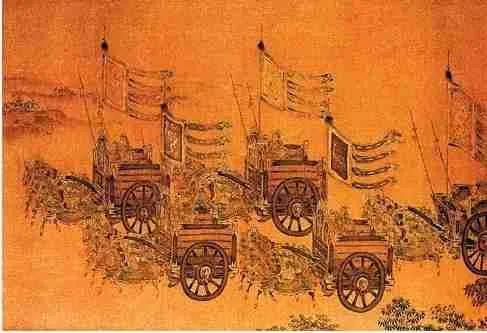
1046BC – The Beginning of the Zhou Dynasty’s Reign (c1046BCE). This year, Zhou, under the leadership of King Wu, would overthrow the Shang Dynast – they used the Mandate of Heaven the overthrow the Shang Dynasty and to justify their ascent to power. The Zhou dynasty would then establish their empire’s capital in Haojing, solidifying their power, even with the feudal states that were led by the local lords who owed their allegiance to the emperor. This period during which the dynasty came into power is the Western Zhou.
What is the Mandate of Heaven?As per traditional Chinese history, it is shown that the Zhou Dynasty ruled after they displaced or overthrew the Shang Dynasty from power. The Zhou would invoke the Mandate of Heaven to legitimize their rule. The Mandate of Heaven is the notion that a ruler, also known as the Son of Heaven, was governed by Divine Right that was granted by the Supreme God of Heaven, but the dethronement of the same ruler would mean that the said ruler had lost their mandate. So, with the demise of the Shang and Xia dynasties as points of reference, this rule is used to justify the legitimacy of rulers such as the Zhou dynasty founded by the Ji family. This dynasty had its capital in Hào. They shared the same cultures and language with the Shang, but thanks to colonization and conquest, they have gradually extended the Shang culture to the rest of China, Proper North of the Yangtze River.
Why Western and Eastern Zhou?Zhou Dynasty was initially under the control of the Ji family, but in 771BCE, and after King You of Zhou had a concubine to replace his queen, the capital was attacked and sacked by the joint forces of the queen’s father, the most powerful Marquess of Sheen and the nomadic tribe. The capital was then moved Eastward as the queen’s son was named the new king (King Ping of Zhou). This proclamation was made by the nobles of the states of Qin, Lü, Zheng, as well as the Marquess of Shen.
The result of this shift was the historical division of the Zhou era into Western and Eastern Zhou that lasted up to 771BCE from 1046BCE (Western Zhou) and from 770-256BCE for Eastern Zhou.
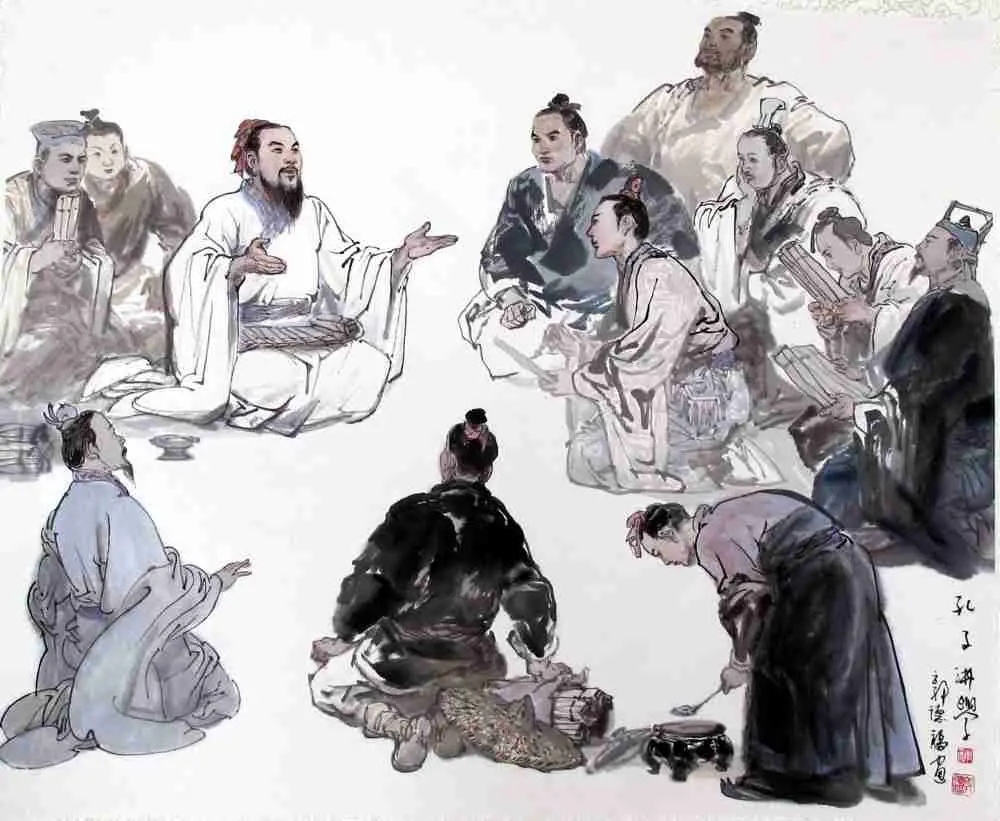
771BC – Attack on Zhou’s Capital. This happened after the king took a concubine and left the queen. The queen’s father was angered, and he, alongside the nomadic tribe of Quanrong, launched an attack on the capital. They later proclaimed the queen’s son and the new king.
770BC – New Capital for Zhou Dynasty is established in Luoyang. This happened after the attack that saw the Ji replaced as the ruling clan and Emperor Ping ascending to power. After these changes, Zhou had control over a very small territory.
Dong Zhou also began in the same year as the ruling powers of the Zhou dynasty declined, and the country was divided into several autonomous feudal states that had very little allegiance to Ping Emperor. These changes created the Eastern Dong Zhou dynasty, and there was a lot of splintering and feudal disorder.
This year also marked the beginning of the Autumn and Spring periods. These, along with Dong Zhou, were also the start of many squabbles between the smaller states. This led to a decline in the emperor’s powers as the feudal lords fought for leadership control.
650BC – Coin minting starts in some of the Chinese states. However, gold wasn’t used for or as money until the 5th Century BCE.
594BC –Tax-By-Land system’s adoption by the state of Lu. This was a period that saw many reforms in taxation. With this system, the amount of tax collected was proportional to the size of land owned. This was a big change that resolved the grievances raised by the peasants while increasing the nation’s revenue.
551BC – Birth of Confucius. Confucius is a name that has become one of the most influential names and philosophical teachers throughout Chinese history. He was born in 551BCE, which is also known as the Warring States Period. Confucius founded the philosophy of Confucianism as an attempt at restoring family order and social harmony.
550BC – This year saw the emergence of the 4 major states of China – Jin (Center), Qin (West), Chu (South), and Qi (East). To date, these 4 states continue fighting for dominance.
510BC – The powerful military strategist and general Sun Tzu writes the book called The Art of War. This book was based on his military experience, and it soon became the most widely read books/ treatises of war, especially during the Warring States Period that came after.
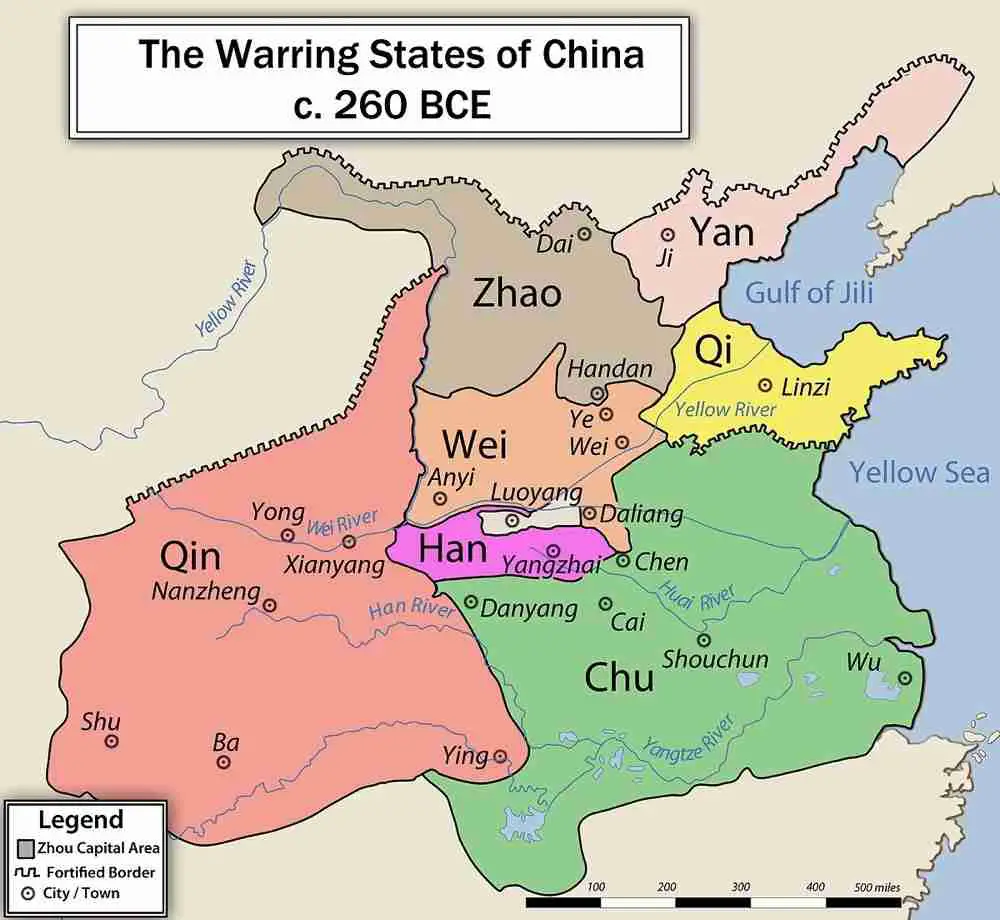
403BC – The center state, Jin, is partitioned, and the infamous Warring States period starts. In 403BC, the Zhou king approved the partitioning of the 3 main families of Jin into three states – the states of Han, Zhao, and Wei. These three states would then begin their struggles for power over China, and they consequently started the Waring States Period. During this period, the reign and power of the Zhou declined significantly, with the government no longer in a position to prevent or control conflicts within the families of the ruling class. The conflicts led to China falling into a state of disorder.
334BC – Wei and Qi Rulers formalize the lost power of the Zhou Empire. This was after decades of fighting, and the rulers of the Qi and Wei states would agree to recognize each other as kings, a move that formalized their independence and the Zhou throne’s loss of power. This was also the start of the Eastern Zhou Dynasty, along with the two other states’ decision to declare kingship, which also signifies the beginning of the end of the Zhou Dynasty.
300BC – Sections of Laozi are available as parts of China. The exact date marking the origin of Laozi, which is the foundational text for Daoism, remains a disputed one, but this is the year that the sections of this text was available in China. Note that the principles of Daoism teach and stress the importance of harmonious living (with the Dao). Dao is believed, in this school of thought/ spiritual belief, to be the powerful guiding force that is behind all reality.
280BC – Birth of Han Fei. Han Fei is considered the biggest contributor to the Legalism philosophy. Han Fei argues that rulers have to use strict laws to be able to control their subjects. Notably, Legalism competes with the Confucianism and Daoism schools of thought and followers.
221BC – Start of The Qin Dynasty. This was after the end of the Warring States Period. Although Qin was a much smaller state, it conquered all other states, leading to the establishment of the Qin Dynasty.
When Did The Zhou Dynasty Start And End?
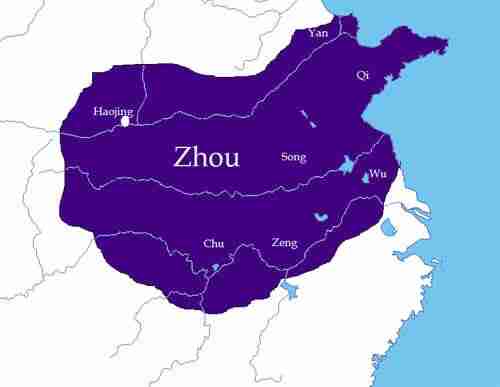
Technically, the Zhou Dynasty started in 1046BC and ended in 221BC, but the actual/ original Zhou Dynasty led by the Ji family (or relatives) ended in 256BC.
Between 771BC and 256BC, the Eastern Zhou dynasty ruled, then there was the Spring & Autumn Period (Dong Zhou Period) between 771BC and 476BC, and finally the Warring States Period between 476BC and 221BC.
Why Did Zhou Dynasty End?
Essentially, the dynasty ended because of family and political feuds that resulted in subdivisions and the subsequent end of the Zhou Dynasty.
Zhou Dynasty Emperors List
Western Zhou
- King Wu 1046–1043 BC
- King Cheng 1042–1021 BC
- King Kang hou 1020–996 BC
- King Zhao 995–977 BC
- King Mu 976–922 BC
- King Gong 922–900 BC
- King Yi 899–892 BC
- King Xiao 891–886 BC
- King Yi 885–878 BC
- King Li 877–841 BC
- Gonghe Regency 841–828 BC
- King Xuan 827–782 BC
- Gongsheng 781–771 BC
Eastern Zhou
- King Ping 770–720 BC
- King Huan 719–697 BC
- King Zhuang 696–682 BC
- King Xi 681–677 BC
- King Hui 676–652 BC
- King Xiang 651–619 BC
- King Qing 618–613 BC
- King Kuang 612–607 BC
- King Ding 606–586 BC
- King Jian 585–572 BC
- King Ling 571–545 BC
- King Jing 544–521 BC
- King Dao 520 BC
- King Jing 519–476 BC
- King Yuan 475–469 BC
- King Zhending 468–442 BC
- King Ai 441 BC
- King Si 441 BC
- King Kao 440–426 BC
- King Weilie 425–402 BC
- King An 401–376 BC
- King Lie 375–369 BC
- King Xian 368–321 BC
- King Shenjing 320–315 BC
- King Nan 314–256 BC
Zhou Dynasty Achievements And Inventions
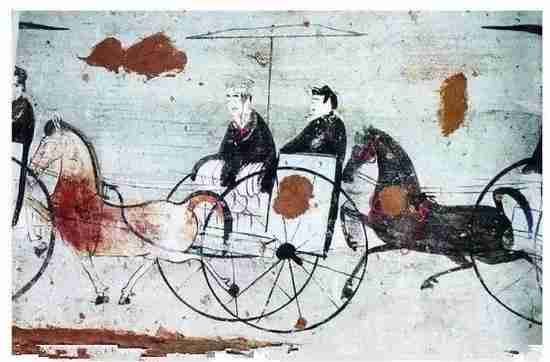
- The Zhou Dynasty is known to have made significant advancements in agriculture, such as the advanced irrigation techniques, the use of hydraulics, and the building of dams, all that helped the Sui Dynasty to build the Grand Canal.
- The dynasty is also known for the use of chariots and cavalries in warfare. They also were behind the popularity of horsemanship which was regarded as a high form of art and a requisite for the education of the princes.
- They were behind the separation of armies into units that would be deployed in battle in different directions.
- They also made advances in metalworking and metallurgy
- Confucianism, Daoism, and Legalism schools of thought were all established by the Zhou Dynasty.
- Major contributions in literature were also made by this dynasty, including legalism texts and preserved histories, poems, and songs. Books written during the period include the works of Confucius, Mencius, and other books titled The Analects of Confucius, The Book of Rites, The Doctrine of the Mean, The I-Ching, The Classics of History, The Classics of Poetry, The Classics of Rites, and The Spring & Autumn Annals.
- They also made significant musical contributions.